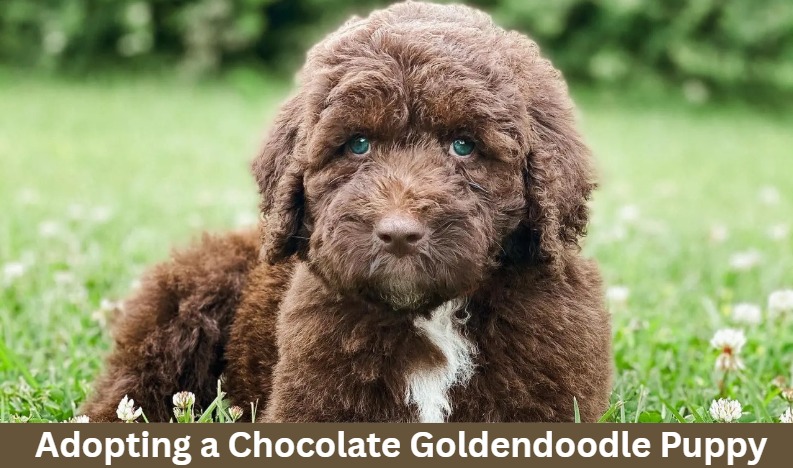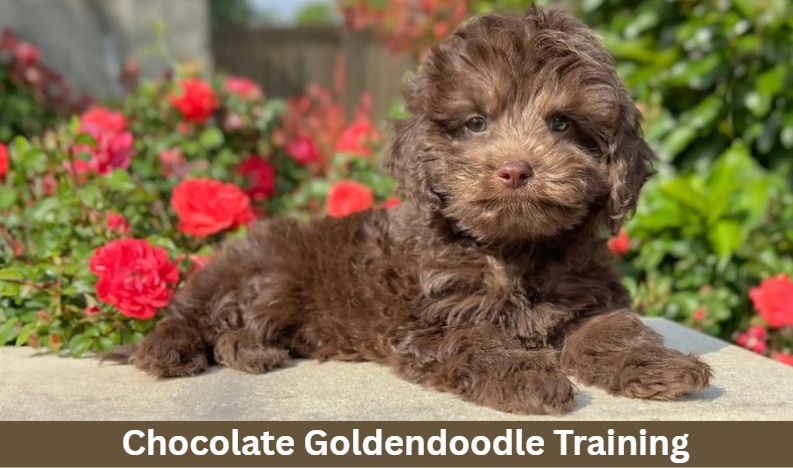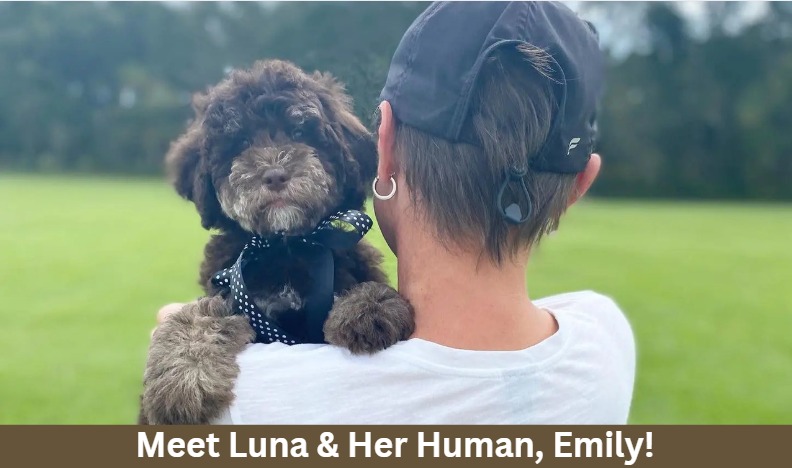
Introduction to the Chocolate Goldendoodle
The Chocolate Goldendoodle is a charming and friendly dog, known for its beautiful coat and loving nature. It’s a mix between a Poodle and a Golden Retriever, two of the most popular dog breeds. Goldendoodles are famous for their intelligence, playfulness, and hypoallergenic qualities. The Chocolate Goldendoodle stands out because of its rich, dark brown coat that gives it a unique look compared to the more common yellow or cream-colored Goldendoodles.
What makes the Chocolate Goldendoodle unique is its stunning color. While many Goldendoodles are lighter in shade, the Chocolate variety offers a beautiful, deep brown hue. This breed also tends to have a gentle temperament, making it an excellent family pet. Whether they are playing in the yard or cuddling with their family, Chocolate Goldendoodles are beloved for their sweet, friendly nature.
Chocolate Goldendoodle: Key Takeaways
| Category | Key Points |
|---|---|
| Appearance | – Rich chocolate coat (light cocoa to deep brown) – Wavy/curly, low-shedding – Amber/hazel eyes common – Merle variant has rare swirled patterns |
| Size | – Mini: 15-35 lbs – Medium: 35-50 lbs – Standard: 50-90 lbs |
| Temperament | – Friendly, social, intelligent – Playful but adaptable – Great with kids/pets |
| Health | – Prone to hip dysplasia, ear infections, allergies – Lifespan: 10-15 years – Require health-tested parents |
| Grooming | – Brush 3x/week, groom every 6-8 weeks – Clean ears weekly – Hypoallergenic (not 100%) |
| Training | – Highly trainable (use positive reinforcement) – Early socialization critical – Puppy classes recommended |
| Price | – Standard: $1,800–$3,500 – Rare (Merle): $3,500–$7,000+ – Adoption: $300–$800 |
| Breeding Ethics | – Avoid merle-to-merle breeding – Studs should have OFA/PennHIP certifications |
| Pros | – Family-friendly – Unique coat color – Low-shedding – Intelligent |
| Cons | – High grooming needs – Prone to separation anxiety – Fading coat possible |
✅ Ideal For: Families, allergy sufferers, active owners.
⚠️ Consider: Grooming costs, exercise needs, ethical breeder selection.
What is a Chocolate Goldendoodle?
Definition and History of the Breed
Goldendoodles first became popular in the 1990s when breeders wanted to combine the Golden Retriever’s kindness with the Poodle’s intelligence and low-shedding coat. The result? A lovable, curly-haired pup that’s great for families and even people with allergies!
Origin of the Chocolate Coat Color
The chocolate brown color comes from the Poodle side. Some Poodles carry a special gene that gives them deep brown fur, and when mixed with a Golden Retriever’s golden genes, you get these adorable chocolate-coated doodles. Sometimes, their coat can fade a little as they grow, but they stay just as sweet!
Chocolate Goldendoodle Coat and Appearance
Chocolate Goldendoodles are like walking teddy bears with their soft, wavy (or curly) brown coats that range from light cocoa to deep, rich chocolate. Their fur can be silky or fluffy, and their eyes often shine with warmth—sometimes even matching their coat with amber or hazel tones!
Understanding the Chocolate Coat
The chocolate color comes from a special gene passed down from Poodles. Unlike black or cream Goldendoodles, chocolate doodles have a solid brown coat that can sometimes lighten slightly as they grow. Their nose and paw pads usually match their fur, staying dark brown for that extra cute factor!
How Does It Differ from Other Goldendoodle Colors?
- Black Goldendoodles have a dark, uniform coat.
- Red Goldendoodles look more like a deep copper or auburn.
- Cream/Apricot Goldendoodles have lighter, golden tones.
But chocolate Goldendoodles stand out with their warm, chocolatey hue—making them extra unique!
Read in detail about: What color are Goldendoodles?
Chocolate Merle Goldendoodle: What Is It?
A Chocolate Merle Goldendoodle is a rare and stunning mix! Their coat has swirling patterns of chocolate brown mixed with lighter patches, almost like a marble cake. This look comes from the merle gene, which creates a mottled, artistic design in their fur. Just remember—merle doodles need extra care, as the gene can sometimes affect their health (like hearing or vision).
Chocolate Goldendoodle Puppies: Your New Bundle of Joy!

Bringing home a Chocolate Goldendoodle puppy is like adopting a playful, fluffy ball of energy! These little pups are extra cuddly, curious, and full of love—ready to become your new best friend.
What to Expect When Adopting a Chocolate Goldendoodle Puppy
- Endless Energy: They love to run, chase toys, and explore everything!
- Super Smart: Thanks to their Poodle genes, they learn tricks quickly (but can be a little mischievous too!).
- Social Butterflies: They adore people, kids, and other pets—perfect for families!
- Chewing Phase: Like all puppies, they’ll nibble on shoes and furniture, so have plenty of chew toys ready!
Size, Coat & Personality as a Puppy
Chocolate Goldendoodle puppies grow fast, so you can expect them to quickly reach their adult size depending on whether they are Mini, Medium, or Standard
Chocolate Goldendoodle Size
| Size | Weight |
|---|---|
| Mini | 15-35 lbs |
| Medium | 35-50 lbs |
| Standard | 50-90 lbs |
- Coat: Their fur starts off soft and slightly wavy, getting curlier as they grow. The chocolate color may lighten a bit but stays adorable!
- Personality:
- Playful & Goofy – Always ready for a game!
- Affectionate – Loves snuggles and belly rubs.
- Eager to Please – Easy to train with treats and praise.
Read our detailed guide about: Sizing up the Goldendoodle breed
Temperament and Personality of Chocolate Goldendoodles
Chocolate Goldendoodles are known for their family-friendly traits. They love being around people and are especially good with kids. Their gentle and affectionate nature makes them perfect family companions. They enjoy spending time with their loved ones, whether it’s playing or simply relaxing at home.
In terms of intelligence and trainability, Chocolate Goldendoodles are highly smart and eager to please. This makes training them relatively easy. They can quickly pick up commands and learn new tricks.
Some common behavioral traits include being playful, energetic, and social. These dogs thrive in active households and enjoy outdoor activities. However, they can also be calm and relaxed when inside, making them adaptable to different environments.
Grooming Your Chocolate Goldendoodle: Keeping That Coat Gorgeous!
A Chocolate Goldendoodle’s fluffy coat is one of their best features—but it needs regular care to stay soft, tangle-free, and healthy. Don’t worry, though! With a simple routine, you can keep your doodle looking (and smelling) like a cuddly teddy bear.
Coat Care & Maintenance
Goldendoodles have low-shedding, curly or wavy coats that can get matted if neglected. Here’s how to keep their fur in top shape:
Brushing: The Key to a Tangle-Free Pup!
- Brush 3-4 times a week (daily if their coat is extra curly).
- Use a slicker brush for detangling and a metal comb for fine-tuning.
- Focus on trouble spots: behind ears, legs, and belly (where mats love to hide!).
- Pro Tip: Spritz with a detangling spray to make brushing easier!
Bathing: Keep Them Fresh & Clean
- Bathe every 4-6 weeks (too much washing can dry out their skin).
- Use a gentle, dog-friendly shampoo (oatmeal-based is great for sensitive skin).
- Rinse thoroughly—leftover soap can cause itching!
- Bonus: After baths, blow-dry on low heat while brushing to prevent mats.
Shedding: Do Chocolate Goldendoodles Shed?
- Good news! They shed very little (thanks to their Poodle genes).
- But they’re not 100% hypoallergenic—some people with allergies may still react.
- Regular brushing helps catch loose hairs before they end up on your couch!
Extra Grooming Needs
✔ Ears: Check weekly for dirt or wax (floppy ears can trap moisture). Clean with a vet-approved ear solution.
✔ Nails: Trim every 3-4 weeks to avoid painful overgrowth.
✔ Teeth: Brush 2-3 times a week to prevent bad breath and dental issues.
When to Visit a Professional Groomer
Even if you groom at home, a pro groomer every 6-8 weeks helps with:
✂ Haircuts (keep their coat manageable with a “teddy bear” or “puppy cut”).
✂ Deep cleaning (ears, nails, and sanitary trims).
✂ De-matting (if tangles get out of hand).
Final Tip: Make Grooming Fun!
- Give treats and praise during brushing so your pup learns to love spa time.
- Start young—puppies who get used to grooming grow into calm, cooperative adults.
With a little love and care, your Chocolate Goldendoodle’s coat will stay as sweet as their personality! 🧼🐾
Training and Socializing Your Chocolate Goldendoodle

Chocolate Goldendoodles are smart, eager-to-please pups—but they need patience, consistency, and lots of love to grow into well-behaved dogs. The good news? Their Golden Retriever charm + Poodle brains make training fun (and often hilarious)!
Basic Training Tips for Chocolate Goldendoodles
1. Start Early (Puppyhood is Key!)
- Begin training as soon as you bring your pup home (8-12 weeks old).
- Use short, 5-10 minute sessions—they’re babies and get distracted easily!
2. Positive Reinforcement = Best Results
- Treats + Praise = Happy Pup! Reward good behavior immediately.
- Try small, soft treats (like training bites or even tiny cheese bits).
- Never yell or punish—they respond best to happy, encouraging vibes.
3. Must-Teach Commands
✔ “Sit” – Easiest first command (hold a treat above their nose, move it back).
✔ “Stay” – Builds impulse control (start with just 2-3 seconds).
✔ “Come” – Lifesaving! Practice in a safe, fenced area first.
✔ “Leave it” – Stops them from grabbing food or dangerous objects.
4. Potty Training 101
- Take them outside every 1-2 hours (after naps, meals, and playtime).
- Pick a potty spot and use a cue word (“Go potty!”).
- Celebrate with treats when they succeed!
5. Stop Nipping & Chewing
- Puppies explore with their mouths—redirect to chew toys (never hands!).
- If they nip, say “Ouch!” and stop playing for 10 seconds (they’ll learn biting = fun ends).
Socializing With Other Pets & People
Goldendoodles are naturally friendly, but early socialization prevents shyness or aggression.
How to Socialize Your Pup
✔ Meet New People – Invite friends over (kids, men, women, hats, sunglasses—expose them to everything!).
✔ Playdates With Dogs – Start with calm, vaccinated dogs (puppy classes are great!).
✔ Explore New Places – Walk in parks, pet-friendly stores, or busy streets (carry them if vaccines aren’t complete yet).
✔ Handle Their Paws & Ears – Gets them used to grooming/vet visits.
What If My Puppy Seems Scared?
- Go slow! Let them observe first, then reward brave behavior.
- Never force interactions—let them approach at their own pace.
Pro Tip: Make It Fun!
- Training = bonding time! Keep sessions short, happy, and rewarding.
- Socialization = adventures! The more positive experiences, the friendlier and more confident your doodle will be.
By 6 months old, your Chocolate Goldendoodle will be a well-mannered, social butterfly—ready for cuddles, playdates, and a lifetime of love!
Read our detailed guide on Goldendoodles are Smartest dog breeds
Health Considerations for Chocolate Goldendoodles

Common Health Issues & Prevention
Chocolate Goldendoodles are generally healthy, but like all breeds, they can be prone to certain conditions:
| Health Issue | Prevention/Treatment |
|---|---|
| Hip/Elbow Dysplasia | – Buy from OFA-certified parents – Keep at a healthy weight – Avoid excessive jumping as a puppy |
| Ear Infections | – Weekly cleaning with vet-approved solution – Keep ears dry after baths/swimming |
| Allergies (Skin/Food) | – High-quality diet – Regular grooming – Omega-3 supplements for skin health |
| Eye Problems (PRA, Cataracts) | – Genetic testing for parents – Annual vet eye exams |
| Bloat (GDV) | – Feed smaller, frequent meals – Avoid exercise right after eating |
Lifespan & Care Tips
✅ Average Lifespan: 10–15 years
✅ How to Help Them Thrive:
- Diet: High-quality protein food (no fillers like corn/wheat)
- Exercise: 30–60 mins daily (walks, playtime, mental stimulation)
- Grooming: Brush 3x/week, professional trim every 6–8 weeks
- Vet Care: Annual checkups + dental cleanings
- Mental Health: Training/puzzles to prevent boredom (they’re smart!)
🔴 Critical Care Tip:
“Pet insurance is worth it! Common claims include ear infections ($200–$500 per visit) and hip dysplasia (surgery can cost $5,000+). Companies like Trupanion cover 90% of costs.”
Chocolate Goldendoodle Full Grown: Size & Changes as They Age
What Size Do They Grow to Be?
Chocolate Goldendoodles grow into three main sizes based on their Poodle parent’s genes. Miniatures stay compact at 15-35 pounds and 13-20 inches tall, perfect for apartment living. Medium doodles hit the sweet spot at 35-50 pounds and 17-21 inches, offering playfulness without being too large. Standards grow big and bold at 50-90 pounds and 20-26 inches, making ideal companions for active families. Remember, their final size depends on whether they come from Toy, Miniature, or Standard Poodle lines – but no matter their size, they all share that signature chocolate-colored charm! Poodle parent was a Toy, Mini, or Standard.
How Their Appearance Changes as They Age
- Coat Color
- Many Chocolate Goldendoodles fade slightly as they grow.
- Their rich brown may lighten to a cafe-au-lait or silvery brown (but some stay dark!).
- Pro Tip: Sun exposure and diet can affect coat color.
- Coat Texture
- Puppy fur is soft and wavy but often gets curlier with age.
- Regular grooming keeps their coat from matting.
- Face & Body
- Their puppy “baby face” sharpens into a more mature look.
- Some develop a beard (thanks to their Poodle genes!).
- Energy Levels
- Puppies = nonstop zoomies!
- Adults = still playful but calmer (perfect for snuggles).
Final Thought
A full-grown Chocolate Goldendoodle is a loyal, loving companion—whether they’re a tiny mini or a big, fluffy standard. And while their coat might change a bit, their sweet personality stays the same!
Adult Chocolate Goldendoodles: Your Perfect Fluffy Companion
An adult Chocolate Goldendoodle is like having a forever puppy – they keep that playful spirit but with a calmer, more mature edge. These medium-to-large dogs typically weigh 35-70 pounds (depending on their size category) and stand about 17-24 inches tall at the shoulder. Their wavy or curly chocolate-colored coat remains one of their most striking features, though some may lighten slightly to a warm caramel shade as they mature.
Personality & Energy
These big-hearted goofballs combine the intelligence of a Poodle with the friendly, outgoing nature of a Golden Retriever. Adults usually mellow a bit from their puppy craziness but still need 1-2 hours of daily exercise – think walks, fetch sessions, or dog park adventures. They thrive on human interaction and can develop separation anxiety if left alone too long.
Grooming Needs
That beautiful coat requires weekly brushing (daily during shedding seasons) and professional grooming every 6-8 weeks. Many owners opt for the popular “teddy bear cut” to keep their fur manageable. Don’t forget regular ear cleaning (those floppy ears trap moisture) and nail trims every 3-4 weeks.
Pro Tip
Adult Goldendoodles are eager to please and respond wonderfully to positive reinforcement training. Their moderate energy and loving nature make them excellent therapy dogs, family pets, or adventure buddies – always ready for cuddles or outdoor fun!
With proper care, your Chocolate Goldendoodle will be your loyal, happy companion for 10-15 years – their puppy-like enthusiasm lasting well into their golden years!
Chocolate Goldendoodle Stud Service
A Chocolate Goldendoodle stud is a healthy, high-quality male Goldendoodle used for breeding to produce puppies with desirable traits—like that rich chocolate coat, friendly temperament, and hypoallergenic curls.
How to Find a Good Stud for Breeding
- Health & Genetic Testing
- A reputable stud should have:
✅ Hip & elbow evaluations (OFA or PennHIP certified)
✅ Eye clearance (CERF or OFA)
✅ Genetic testing (for PRA, von Willebrand’s, etc.) - Avoid studs without health clearances—breeding unhealthy dogs risks passing on problems.
- A reputable stud should have:
- Temperament & Conformation
- Look for a calm, confident personality (no aggression or extreme shyness).
- The stud should match the breed standard (well-proportioned, good coat structure).
- Proven Breeding Experience
- Studs with previous litters are preferred—ask for references.
- Check if his puppies have been healthy and well-tempered.
- Color & Coat Genetics
- If breeding for chocolate coats, ensure the stud carries the brown (b) gene.
- For merle patterns, verify the stud is ethically bred (merle-to-merle breeding is dangerous).
- Where to Look
- Reputable Goldendoodle breeders (ask for recommendations).
- AKC or Goldendoodle Association listings.
- Avoid random online ads—always visit and meet the stud in person.
The Breeding Process
- Female Readiness
- The female must be in heat (around day 10-14 of her cycle).
- A vet can confirm ovulation timing via progesterone testing.
- Natural vs. Artificial Insemination
- Natural breeding: Supervised mating (best for experienced dogs).
- AI (Artificial Insemination): Used if the stud/female are far apart or inexperienced.
- Pregnancy & Whelping
- Pregnancy lasts ~63 days.
- Provide the mom with quality nutrition, vet checks, and a whelping area.
- Ethical Considerations
- Only breed if you can responsibly place all puppies.
- Avoid overbreeding the stud (max 2-3 litters/year for his health).
Final Tip
Breeding Chocolate Goldendoodles should be done thoughtfully—always prioritize health, temperament, and ethical practices over just coat color. A good stud ensures happy, healthy puppies!
Finding Chocolate Goldendoodle Puppies for Sale

Where to Look for Chocolate Goldendoodle Puppies
- Reputable Breeders
- The best option for healthy, well-socialized puppies.
- Look for breeders registered with GANA (Goldendoodle Association of North America) or ALAA (Australian Labradoodle Association of America).
- Online Platforms
- AKC Marketplace (filter for Goldendoodles)
- Good Dog (vetted breeders with health guarantees)
- Local Facebook Groups (search “Goldendoodle Puppies [Your State]”)
- Avoid: Puppy mills or Craigslist—these often have unhealthy, poorly bred dogs.
- Rescues & Rehoming
- Check Doodle Rescue Collective or Petfinder—sometimes adult Chocolate Goldendoodles need new homes!
Tips for Choosing a Responsible Breeder
✅ Health Testing – Parents should have:
- Hip/elbow certifications (OFA/PennHIP)
- Genetic tests (PRA, von Willebrand’s, etc.)
- Up-to-date vaccinations & deworming records
✅ Transparent Practices – A good breeder will:
- Let you visit their facility
- Show you the puppy’s parents
- Provide a health guarantee
✅ Socialization – Puppies should be raised in a home environment (not a kennel) and exposed to sounds, people, and handling.
🚩 Red Flags
- No health testing
- Multiple litters always available
- Refuses to let you meet the mom
- Pressure to pay upfront without questions
Questions to Ask Breeders
- Health & Genetics
- “Can I see the parents’ health clearances?”
- “Do you test for common genetic issues in Goldendoodles?”
- Breeding Practices
- “How many litters do you breed per year?”
- “How do you socialize the puppies?”
- Puppy Policies
- “What’s included in the purchase price? (Vet checks, first shots, microchip?)”
- “Do you offer a health guarantee?”
- “What’s your policy if I can no longer care for the puppy?”
- About the Puppy
- “Can I meet the puppy’s parents?”
- “What’s the puppy’s temperament like?”
A well-bred Chocolate Goldendoodle may cost more upfront, but it saves you thousands in vet bills and heartache later. Always trust your gut—if something feels off, walk away!
What is the Price of a Chocolate Goldendoodle?
| Type | Price Range | Key Features |
|---|---|---|
| Standard Chocolate Goldendoodle | $1,800–$3,500 | Most common size, great for families |
| Medium Chocolate Goldendoodle | $2,000–$4,000 | Popular for their manageable size |
| Mini/Teacup Chocolate Goldendoodle | $2,500–$5,000+ | High demand due to compact size |
| Rare Coat (Merle, Phantom, Parti) | $3,500–$7,000+ | Unique patterns like chocolate merle |
| F1B (75% Poodle) | $2,500–$5,000 | Best for allergy sufferers, curlier coats |
Notes:
- Prices vary by breeder reputation/location
- Rare colors (merle) command premium pricing
- Always verify health testing for parents
A Real Chocolate Goldendoodle Love Story: Meet Luna & Her Human, Emily!

When Emily first held her Chocolate Goldendoodle puppy, Luna, she knew she’d found something special. “I was drawn to that rich, cocoa-colored coat,” Emily recalls, “but I had no idea Luna would become my shadow, my therapist, and my daily dose of laughter all rolled into one fluffy package.”
The Puppy Phase: Sweet But Sneaky
Luna’s puppyhood was equal parts adorable and mischievous. “She potty-trained surprisingly quickly,” Emily says, “but also developed a notorious sock-stealing habit—I still find hidden stashes under the couch!” Luna’s Poodle smarts meant she learned commands fast, though Emily jokes, “She’s too clever—sometimes she ‘forgets’ commands when she’s not in the mood.”
The Teenage Months: Testing Boundaries
At 10 months old, Luna went through her rebellious phase. “Suddenly my perfect puppy pretended not to hear ‘come’, especially at the dog park,” Emily laughs. But with positive reinforcement and lots of patience, Luna matured into a well-behaved companion. “The turning point was puppy classes—she loved showing off her skills for treats!”
Life Today: Unbreakable Bond
Now 2 years old, Luna has settled into Emily’s life perfectly:
- Morning ritual: Demands cuddles before Emily’s alarm even goes off
- Work from home days: Serves as the world’s cutest coworker, alternating between napping on Emily’s feet and “supervising” out the window
- Weekend adventures: Lives for hiking trips (though she still hasn’t learned not to roll in every interesting smell)
Emily’s Hard-Earned Wisdom for New Owners:
- “Grooming is non-negotiable—get them used to brushing young, or you’ll regret it!”
- “They’re people dogs—Luna gets sad if left alone too long. Doggy daycare was a game-changer.”
- “The chewed shoes are worth it—that wagging tail when I come home makes every destroyed item fade from memory.”
Final Thought from Emily:
“Luna turned out to be so much more than a pretty face. That goofy, chocolate-colored ball of energy somehow knows when I’ve had a bad day and always knows how to make it better. She’s not just my dog—she’s my heart.”
(A genuine, heartfelt story that captures the real joys and challenges of life with a Chocolate Goldendoodle!) 🐾✨
Do you have a Chocolate Goldendoodle story? We’d love to hear your experiences in the comments!
Why Choose a Chocolate Goldendoodle?
1. Irresistible Looks
Chocolate Goldendoodles stand out with their rich, warm coat colors—ranging from deep mocha to creamy caramel. Unlike common gold or cream doodles, their unique brown hue gives them an extra dose of charm.
- Eye-catching: Their amber or hazel eyes often complement their coat, making them look like living teddy bears.
- Less Fading: While some lighten slightly, chocolate coats stay truer to color compared to red or apricot doodles that often fade dramatically.
- Rare & Special: Not as common as golden shades, giving them an exclusive appeal.
2. Wonderful Personality
They inherit the best traits from Golden Retrievers and Poodles:
✔ Friendly & Social – Loves everyone (kids, strangers, other pets).
✔ Smart & Trainable – Learns commands quickly (great for first-time owners).
✔ Playful but Adaptable – Happy with hikes or couch cuddles.
✔ Low-Shedding – Better for allergy sufferers than traditional Retrievers.
3. Why Choose Chocolate Over Other Colors?
- Less Common – More unique than the typical gold/cream.
- Photogenic – Their rich color looks stunning in photos.
- Hides Dirt Better – Light coats show grass stains more easily!
A Chocolate Goldendoodle isn’t just a pet—they’re a showstopping companion with a heart of gold. Whether you want a family dog, therapy animal, or adventure buddy, their looks + personality make them unforgettable!
🐾 Pro Tip: Choosing a Puppy
“When visiting breeders, watch how puppies interact with littermates. The bold, curious ones often have confident personalities—perfect for active homes. Shy pups may need extra patience but can be just as loving!”
Conclusion: Is a Chocolate Goldendoodle Right for You?
If you’re looking for a smart, affectionate, and strikingly beautiful dog, a Chocolate Goldendoodle could be your perfect match! With their warm brown coats, playful personalities, and low-shedding fur, they’re ideal for families, singles, and even allergy sufferers. While they require regular grooming, training, and exercise, the reward is a loyal, happy companion who brings endless joy. Just remember to choose a reputable breeder or rescue to ensure a healthy, well-adjusted pup. If you’re ready for a lifelong cuddle buddy with good looks and a big heart, this charming doodle might just be your dream dog! 🐾💛
Frequently Asked Questions (FAQs)
Do Chocolate Goldendoodles fade?
Yes, many Chocolate Goldendoodles lighten over time, sometimes turning a soft silver or café color.
Are Chocolate Goldendoodles rare?
Yes, they’re less common than cream or apricot ones due to the genetics needed for the chocolate coat.
Can Goldendoodles eat chocolate?
No, chocolate is toxic to all dogs, including Goldendoodles, and can make them very sick.
What happens if a Goldendoodle eats chocolate?
They may vomit, have diarrhea, or worse—contact a vet immediately if your dog eats chocolate.
What is the lifespan of a Chocolate Goldendoodle?
Most live between 10 to 15 years, depending on their size, genetics, and health care.
Are Chocolate Goldendoodles hypoallergenic?
They are low-shedding and allergy-friendly, especially if they have more Poodle genes, but not fully hypoallergenic.
How often should I groom my Chocolate Goldendoodle?
Brush them 3–4 times a week and get professional grooming every 6–8 weeks.
What are common health issues in Chocolate Goldendoodles?
They can have hip dysplasia, ear infections, and skin issues, especially if not groomed regularly.
How much exercise does a Chocolate Goldendoodle need?
They need at least 30 to 60 minutes of active play or walking each day.
What is the rarest color for a Goldendoodle?
Phantom and merle colors, including chocolate merle, are among the rarest.
How much is a Chocolate Goldendoodle?
They usually cost between $2,000 to $4,000 depending on size, coat, and breeder reputation.
What is the most desirable color for a Goldendoodle?
Apricot and red are very popular, but chocolate is growing in demand for its unique beauty.
Is a boy or girl Goldendoodle better?
Both are loving and loyal; males are often more playful, while females may be a bit more independent.





Comments (2)
Beauty Fashionsays:
October 5, 2025 at 3:24 amIt’s great that you are getting ideas from this article as well as from our argument made at this time.
Beauty Fashionsays:
October 5, 2025 at 4:31 amHello, I enjoy reading through your article. I wanted to write a little comment to support you.